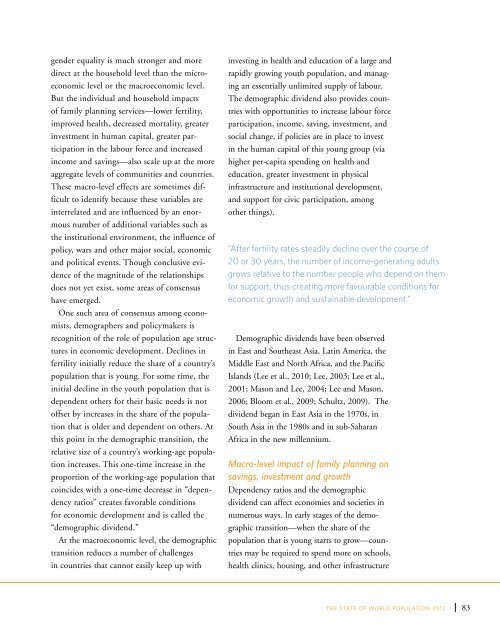State of World Population 2012 - Country Page List - UNFPA
State of World Population 2012 - Country Page List - UNFPA
State of World Population 2012 - Country Page List - UNFPA
Create successful ePaper yourself
Turn your PDF publications into a flip-book with our unique Google optimized e-Paper software.
gender equality is much stronger and more<br />
direct at the household level than the microeconomic<br />
level or the macroeconomic level.<br />
But the individual and household impacts<br />
<strong>of</strong> family planning services—lower fertility,<br />
improved health, decreased mortality, greater<br />
investment in human capital, greater participation<br />
in the labour force and increased<br />
income and savings—also scale up at the more<br />
aggregate levels <strong>of</strong> communities and countries.<br />
These macro-level effects are sometimes difficult<br />
to identify because these variables are<br />
interrelated and are influenced by an enormous<br />
number <strong>of</strong> additional variables such as<br />
the institutional environment, the influence <strong>of</strong><br />
policy, wars and other major social, economic<br />
and political events. Though conclusive evidence<br />
<strong>of</strong> the magnitude <strong>of</strong> the relationships<br />
does not yet exist, some areas <strong>of</strong> consensus<br />
have emerged.<br />
One such area <strong>of</strong> consensus among economists,<br />
demographers and policymakers is<br />
recognition <strong>of</strong> the role <strong>of</strong> population age structures<br />
in economic development. Declines in<br />
fertility initially reduce the share <strong>of</strong> a country’s<br />
population that is young. For some time, the<br />
initial decline in the youth population that is<br />
dependent others for their basic needs is not<br />
<strong>of</strong>fset by increases in the share <strong>of</strong> the population<br />
that is older and dependent on others. At<br />
this point in the demographic transition, the<br />
relative size <strong>of</strong> a country’s working-age population<br />
increases. This one-time increase in the<br />
proportion <strong>of</strong> the working-age population that<br />
coincides with a one-time decrease in “dependency<br />
ratios” creates favorable conditions<br />
for economic development and is called the<br />
“demographic dividend.”<br />
At the macroeconomic level, the demographic<br />
transition reduces a number <strong>of</strong> challenges<br />
in countries that cannot easily keep up with<br />
investing in health and education <strong>of</strong> a large and<br />
rapidly growing youth population, and managing<br />
an essentially unlimited supply <strong>of</strong> labour.<br />
The demographic dividend also provides countries<br />
with opportunities to increase labour force<br />
participation, income, saving, investment, and<br />
social change, if policies are in place to invest<br />
in the human capital <strong>of</strong> this young group (via<br />
higher per-capita spending on health and<br />
education, greater investment in physical<br />
infrastructure and institutional development,<br />
and support for civic participation, among<br />
other things).<br />
“After fertility rates steadily decline over the course <strong>of</strong><br />
20 or 30 years, the number <strong>of</strong> income-generating adults<br />
grows relative to the number people who depend on them<br />
for support, thus creating more favourable conditions for<br />
economic growth and sustainable development.”<br />
Demographic dividends have been observed<br />
in East and Southeast Asia, Latin America, the<br />
Middle East and North Africa, and the Pacific<br />
Islands (Lee et al., 2010; Lee, 2003; Lee et al.,<br />
2001; Mason and Lee, 2004; Lee and Mason,<br />
2006; Bloom et al., 2009; Schultz, 2009). The<br />
dividend began in East Asia in the 1970s, in<br />
South Asia in the 1980s and in sub-Saharan<br />
Africa in the new millennium.<br />
Macro-level impact <strong>of</strong> family planning on<br />
savings, investment and growth<br />
Dependency ratios and the demographic<br />
dividend can affect economies and societies in<br />
numerous ways. In early stages <strong>of</strong> the demographic<br />
transition—when the share <strong>of</strong> the<br />
population that is young starts to grow—countries<br />
may be required to spend more on schools,<br />
health clinics, housing, and other infrastructure<br />
THE STATE OF WORLD POPULATION <strong>2012</strong><br />
83
















